Surge protector secrets you're not supposed to know...
© Paul Quillen 1991-2020
Everyone knows that a surge protector is necessary. It's typically an afterthought when buying a computer, stereo, industrial control panel, or any other expensive electronics.
Most give little thought to it's purchase, simply buying whatever the salesman happens to be pushing. Many times it's only $20. Other times you are steered to a $129 protector. And you see all kinds of "connected-equipment" guarantees. And all kinds of claims about surge and spike performance.
What's really going on? Sit back and buckle up.
You're not going to believe what a scam most of these products are. Virtually all of them are designed incorrectly. That's right. I said designed incorrectly.
But first you need to understand that spikes, those very brief voltages that may go up into the hundreds or thousands of volts will slowly degrade all the solid state devices they hit. If they're strong enough they can destroy solid state devices. Weaker ones degrade the junctions within semiconductors. And these spikes can contaminate your data. They frequently cause unexplained problems that no one can figure out. They're especially hard on networks.
There are two completely different schools of thought on power protection.
Parallel vs. Series
Parallel just means that the protection devices are placed across the wires. They're connected hot to neutral, hot to ground, and neutral to ground. If there is a spike over a couple of hundred volts, these devices divert it to ground where they claim it does no harm.
Ground means some point on the ground circuit. This is where the problem begins.
Many people erroneously think that ground is ground. It is if you're talking about DC or 60 Hz AC. But it isn't to a spike. Spikes contain high frequency components which can create voltage differences on a ground wire. In other words, the spike can travel through the ground wire and enter your electronic equipment.
Why are surge protectors designed this way? Simple. It's cheap. The most common item used in a parallel type surge protector is an MOV. That stands for Metal Oxide Varistor. These essentially act as a short to high voltages.
They are connected as mentioned above. Across the wires. So if you get a spike in the hot wire, the MOV conducts and dumps it onto the ground wire where it travels unimpeded into your electronics. They didn't tell you this, did they?
There are other parallel devices that act similarly such as the gas discharge tube, transzorbs, and others. Same story. The spike gets dumped onto the ground wire and travels directly into your electronics.
Wait, there's more. All parallel type devices have a delay time before they act. That's not good.
Still more: MOV's, the most common parallel device used in these surge protectors, degrade fairly quickly. Each spike they dump to ground degrades them. After a while they don't do anything except possibly catch on fire. That's right, there are many cases of MOV's catching on fire and destroying themselves. And in some cases MOV's explode and destroy the whole surge protector unit.
Many of the higher priced parallel type surge protectors do contain small coils that are, in fact, in series with the hot wire. But these do virtually nothing to slow down a spike. Their primary function is to block radio frequency interference from coming into your electronics via the hot wire. They do this nicely, but do virtually nothing to attenuate a spike. So don't be confused if you look inside one of these parallel type surge suppressors and see some small coils.
Same with any capacitors you may see. They're in there for radio frequency interference suppression, not spike suppression.
It gets even worse if you have a network. Networks usually use ground as a voltage reference for a 5 volt signal. These parallel type surge suppressors dump a several hundred to several thousand volt spike onto your network voltage reference. Can you imagine what this does to your data?
What should you do?
Don't buy a parallel type surge suppressor.
How do you find out? Just ask if it contains MOV's. If the salesman doesn't know, look inside. They are disks about an inch in diameter, about an 1/8 inch thick, with 2 wires sticking out the bottom of the disk. You can't miss them.
MOV's cost about 25 cents at the Original Equipment Manufacturer level. No wonder they love them.
"But they have a connected-equipment guarantee."
So what. You have to let your computer be destroyed to collect on their guarantee if their weasel clauses don't keep them from paying. What does down-time cost you? Do they compensate you for down-time? Of course not. So a $129 surge protector with a connected-equipment guarantee could end up costing you thousands in downtime.
Even if it's a home computer, the time and data you can lose will cost you far more than the cost of a properly designed surge protector.
One more thing about these guarantees have you ever heard of anyone actually collecting? Ill bet not, due to the insurmountable qualifying hurdles.
So what's the solution.
The best solution would be to stop the spikes before they get into your equipment. You certainly don't want to dump them onto the ground which is hard-wired to your equipment (as required by code).
This is where series type devices come in.
What is a series type device? It works oppositely from the parallel type devices. Remember that parallel type devices go across the wires. From hot to ground, for example.
Series type devices are inserted "between" the hot wire coming from the wall outlet and the hot wire going into your electronics. In other words, the electricity has to travel "through" the series type device to get to the computer.
The oldest series protection device is the ferro-resonant transformer. It's been around for years and does a wonderful job stopping spikes and radio frequency interference.
Ferro-resonant transformers work. But they have a few drawbacks. They are quite expensive. You're looking at $hundreds to over a $thousand for the sizes that would handle a computer to one that would handle a computer with a laser printer. They generate a lot of heat which also means they waste electricity. They have an audible hum which is quite annoying. (Sort of like a noisy fluorescent light.) And lastly, they have a fairly high output impedance which computer switch-mode power supplies don't particularly like.
What about the surge protection built into uninterruptible power supplies? I'm talking about the common standby type that kick on the inverter within milliseconds after a power failure. This is the most common type of UPS used on small computers. As long as there is power coming from the wall outlet, these standby UPS' are off. When they are off, they are functionally equivalent to a parallel surge protector.
So we've still got the same problem with almost every standby UPS on the market. The same 25 cent MOV's are used. The few that don't use MOV's use ferro-resonant transformers and are expensive and have all the ferro-resonant transformer drawbacks.
So what do you do?
Luckily, a few years back, a small company developed a series type surge protector that's light weight, small, quiet, cool, and priced not much higher than the better parallel type surge protectors but lower than the expensive ferroresonant transformers.
It contains no MOV's or other consumable parallel devices.
So there is nothing to degrade in it.
And there's nothing in it that could dump the spike onto the ground where it could zip right into your equipment.
But how did it's designers handle the spike? This is the most interesting part: The unit absorbs the spike. Then it very slowly and harmlessly bleeds the energy from the spike into the neutral wire, not the ground wire.
Slowly bleeding the energy into the neutral wire was a stroke of genius. The neutral goes into your computer's power supply and the power supply doesn't even flinch from this small bleed of energy.
Let me give you an analogy.
Let's say you have a vegetable garden with a number of small plants in it. You're watering the plants with a hose with light water flow. All of a sudden the is a tremendous surge of high pressure water through the hose and it destroys your small vegetable plants. Knocks them right out of the ground.
That's a spike. The high pressure burst of water is analogous to a high voltage spike.
Now put a bucket between the plants and the hose. The bucket has a small hole in it. You put water into the bucket at any flow rate you want but the water hitting the plants is controlled by the small hole. The bucket is in series with the water flow. The water has to go "through" the bucket to get to the plants. If there is a water surge in the hose, the plants won't know it. It will just temporarily raise the water level in the bucket. This will temporarily increase the water flow to the plants through the small hole, but barely noticeably.
No damage whatsoever to the small plants.
No damage whatsoever to your electronics.
Common Mode
What we've just looked at is called Normal Mode protection. Normal mode is a spike that occurs between the hot and neutral. It's called Normal mode because this is the normal way spikes appear -- between the hot and neutral.
But what about Common Mode protection?
Common-mode spikes are "created" by parallel-type surge protectors. Common mode spikes are different.
Common mode is a spike between the neutral and ground -- the white and green (or bare) wires. This is called common mode because the neutral and ground have a common point. This common point is where they are physically tied together at the breaker panel.
Normal mode is the only way a spike can get into your building from the outside.
Outside your building, neutral and ground are the same wire. And the ground/neutral outside the building is grounded to the earth both at the pole and at your building. If you have overhead wires from the pole, it's the bare wire.
The further from the breaker panel, the more impedance in the ground and neutral wires. Thus the further you get from the breaker panel, the higher the voltage spike that can be generated between the neutral and ground.
They're supposed to be at the same potential, but the further from the breaker panel, the easier it is to impress a voltage spike between neutral and ground.
The closer to the breaker panel, the more difficult it would be to generate a spike between the neutral and ground. Remember, neutral and ground are physically tied together at the breaker panel. A spike between neutral and ground is a common mode spike. Common because the two wires have the "common" point at the breaker panel.
Again, normal mode spikes are between hot and neutral. This is the only way a spike can get into the building from the outside.
A common mode spike is between neutral and ground. Since neutral and ground are the same wire outside the building, a common mode spike cannot be generated outside the building. All common mode spikes have to be "created" inside the building.
So you only have to protect for normal mode spikes unless "you" do something inside the building to put a spike between the neutral and ground at some point downstream from the breaker panel. A voltage spike between the neutral and ground is called a common mode spike. Remember, common mode spikes have to be created inside the building.
Common mode spikes are caused by parallel type surge protectors. That's right! The MOV's, gas discharge tubes, transzorbs, and other parallel surge protector devices in all parallel surge suppressors actually cause common mode spikes. That's why some feel it's better to have no surge suppressor than to have any surge suppressor with parallel devices. Unbelievable, but true.
The branch circuit from the breaker panel that feeds a computer should contain absolutely no parallel type surge devices as these can create common mode spikes.
One more point about common mode spikes. Computers are inherently capable of handling common mode spikes of moderate intensity. So not only is this not a real-world problem, but even if there were a modest common mode spike, the computer would handle it by itself without problems.
UPS (Uninterruptible Power Supply)
If you use a UPS, it should be in the circuit downstream from the series type surge protector. Some engineers even feel that the parallel devices (MOV's, etc.) inside the UPS should be physically removed.
Telephone Line Protectors
What about telephone line protectors? The phone line is inherently a high impedance circuit to spikes and is protected at the interface box to 300 volts. Phone line protectors that plug into a wall outlet either directly or with a cord are parallel type protectors. These put spikes onto the ground where they travel right into your computer or they upset the ground reference on a network. In other words, grounded telephone line protectors create common mode spikes.
Conventional Wisdom
I'm sorry if I'm upsetting the conventional wisdom apple cart, but this is reality. The sales departments of the parallel type surge suppressor manufacturers have no knowledge of this (based on our discussions with them). And they don't want to. Why would they want to learn something which if implemented would decrease their profitability?
Advertising Half-Truths
At least one of the parallel (shunt) type manufacturers has resorted to calling their units dual-mode, implying that they have series and parallel protection.
There are two problems with this. The first is that they don't have true series protection and the second is that you don't want parallel protection.
In other words, you don't want dual-mode. You want single mode -- series.
What they do have is EMI and RFI filters. Some of the components of these EMI RFI filters are in series. But this is not series mode spike protection. Don't be fooled by these tactics.
Another misleading sales pitch is 3-modes-of-protection. This is nothing but three 25 cent MOVs across the 3 sets of wires. Hot to Ground, Hot to Common, and Common to Ground. Sure does sound impressive though.
Confusion
After reading all the literature from all the surge protection manufacturers, it's easy to get confused. The most likely result is for one to give up and simply buy a protection device based upon price alone and say, "Oh, I just have one computer and I'm sure this is good enough for me." This is exactly what their advertising gimmicks are designed to do. Don't fall for it.
"But I really don't think I have a surge problem."
I'll bet you do. Here's why. I've done surge tests in many homes and offices and found plenty of harmful surges in both. Anything containing a motor or a transformer can cause spikes from within the home or office. For example, if you have any of the following equipment in your home or office, you will have spikes generated right inside the building.
- refrigerator
- air conditioning or heating system
- vacuum cleaner
- freezer
- hair dryer
- blender
- attic fan
- sump pump
- well pump
- copy machine
- microwave oven
Even if you didn't have any of these, your neighbor who is on the downstream side of the same power pole transformer as you, can generate spikes and those will appear in your home or office.
If your electronics are inside an industrial plant, you unquestionably have spikes.
Don't Rely on "Consumer Reports"
Consumer Reports said, "And computer hard drives sometimes sustained damage from a spike reaching them via an apparently undamaged suppressor."
They were referring to parallel surge protectors. They offered no explanation. The explanation is obvious: The spike used the parallel protection device such as an MOV to contaminate the ground. So the spike easily entered the computer via the ground wire.
Consumer Reports also said, "Most suppressors have circuitry to absorb surges between any pair of the three wires in an electrical circuit -- the ground wire, the "hot" or line wire, and the neutral wire, which can be paired three ways."
Consumer Reports is parroting the old disproved theory that 3 MOVs should be used. We now know that this approach is the cause of surges entering your equipment.
The parallel devices don't absorb much of a large surge. They can't. They're physically too small. Sure, they absorb what they can. But if the energy surge exceeds their capacity, then they get hot rather quickly. We have photographs of burnt and exploded MOVs. While this is happening, much of the energy is passed through to the other conductor and into your equipment.
"Surges are only 2% of the problem. You need a UPS. And it comes with built-in surge protection at no extra charge and at a cost less than surge protection alone."
This is a very crafty marketing technique used by some manufacturers. What they are really doing is trying to minimize the importance of surge protection in your mind since their surge protection is inferior (25 cent MOVs).
But it's the surges, not power failures, that destroy equipment.
If you need a UPS due to an unreliable power company, then buy an inexpensive UPS and put it in the circuit after a high quality series-mode surge protector. This way, both the UPS and your equipment will be protected from surges.
Think RF
Anytime you're thinking about spikes or lightning, you have to think in terms of radio frequencies (RF), not DC. Ham radio operators fully understand that at radio frequencies, what you think is ground isn't necessarily ground.
New Federal Government Requirements
The Federal Government has a Commercial Item Description (CID) for the purchasing of power line surge suppressors by all Federal Agencies. The new CID defines Grade A, B and C suppressors, based on ENDURANCE and PERFORMANCE testing which is now being offered as an option by Underwriters Laboratories, Inc. (UL).
Prior to this new CID, we had only the UL 1449 safety specification and the manufacturer's claims to rely on. UL 1449 has nothing to do with performance and endurance. So up until now there was NO testing for performance and endurance. In fact, even now, for non-Federal Government purchases, this new testing is optional. So don't expect to see it on any surge protectors at the store. Now we will also have the endurance and performance specs that will result from the new supplemental testing being offered by UL to manufacturers.
The series-mode suppressors mentioned above have already easily passed the most rigorous "Grade A" tests. The Grade A test uses 1,000 surges at 6,000 Volts and 3,000 Amperes. This is a tough test. And the series mode unit passed it easily.
Based on published MOV data, MOV-based products most likely won't even get 10% into the easy "Grade C" tests before failing. Grade C tests require 1,000 surges at only 2,000 Volts and at only 1,000 Amperes.
In the following oscilloscope traces, the top trace is the "let-through" Voltage, and the bottom trace is the ground wire current. Let-through Voltage should be very small and the ground wire current should be zero. The difference between the Zero Surge Series Mode type of protection and their competitors' shunt mode technology explains the difference between Zero Surge and all the rest. These are actual oscilloscope traces. This is the acid test. The buck stops here...
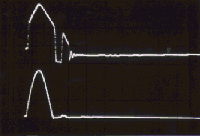 APC Network Surge Arrest Net7
APC Network Surge Arrest Net7
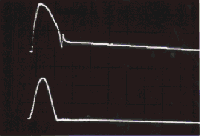 EFI Power Trax 2000
EFI Power Trax 2000
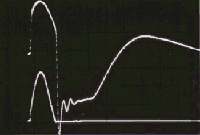 Equalizers Trace
Equalizers Trace
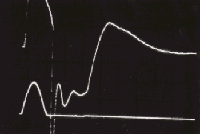 JCP&Ls Trace
JCP&Ls Trace
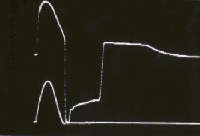 S.L. Waber Surge Sentry Model DSD
S.L. Waber Surge Sentry Model DSD
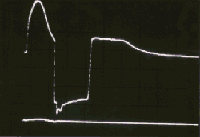 Transtector SLV
Transtector SLV
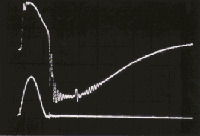 Tripplite Isobar Ultra 6
Tripplite Isobar Ultra 6
And finally, the solution...
 Zero Surge Model 2R15W
Zero Surge Model 2R15W
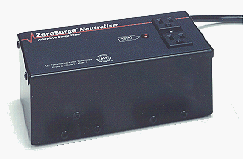 Zero Surge Model 2R15W; 4.75 lb.; 15 Amps; only $205.00 + $25.63 S&H for a total of $230.63 USD in the lower 48 U.S.A.
Zero Surge Model 2R15W; 4.75 lb.; 15 Amps; only $205.00 + $25.63 S&H for a total of $230.63 USD in the lower 48 U.S.A.
Have more questions? Want to know how to hook up your Zero Surge? Click Here for the FAQ.
Purchase Info
We use, recommend, and sell the Zero Surge Model 2R-15W. It's $243.75 plus S&H but we sell it for $205.00 USD plus $25.63 USD S&H for a total of $230.63 USD within the lower 48 U.S.A. If you are outside the lower 48, please call 770-382-9656 or email us and give us your full street address so we can determine shipping charges. If you are on 220 Volts, don't order, as this unit is for 120 Volts only.
Credit Card: To purchase a Zero Surge Model 2R-15W with your credit card, just call 770-382-9656 between 10:00 and 3:00 Eastern, Monday thru Friday.
PayPal: You can also purchase a Zero Surge with PayPal. Just click on the PayPal Buy Now button below. If you fund PayPal with a credit card, the charge will appear on your credit card statement as PAYPAL*ETOWAHVALLE.
To pay by check or money order, make it payable to Etowah Valley Inc. and mail it to:
Paul Quillen
Etowah Valley Inc.
99 Twelve Oaks Drive
Cartersville, GA 30120
Office Phone: 770-382-9656 (Eastern Time Zone)
Cell Phone: 678-986-8602 (Eastern Time Zone)
Email us
All sales are final. No refunds.